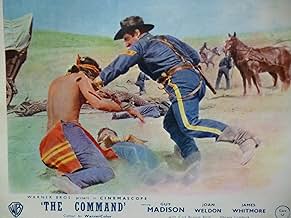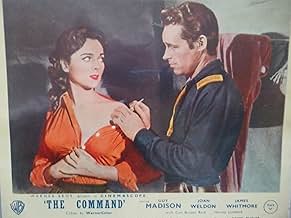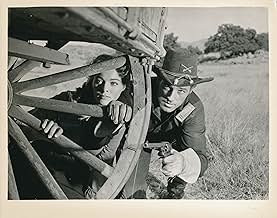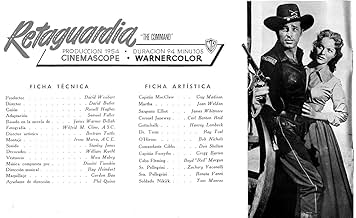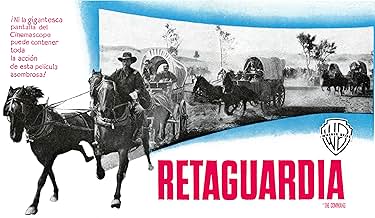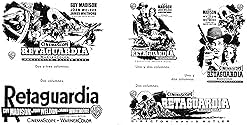Un médico del ejército, sin experiencia en combate, se ve obligado a asumir el mando de una tropa de caballería que escolta una caravana a través de un territorio indio hostil cuando muere e... Leer todoUn médico del ejército, sin experiencia en combate, se ve obligado a asumir el mando de una tropa de caballería que escolta una caravana a través de un territorio indio hostil cuando muere el oficial al mando de la unidad.Un médico del ejército, sin experiencia en combate, se ve obligado a asumir el mando de una tropa de caballería que escolta una caravana a través de un territorio indio hostil cuando muere el oficial al mando de la unidad.
- Dirección
- Guionistas
- Elenco
- 2nd Lt. O'Hirons
- (as Bob Nichols)
- Trooper
- (sin créditos)
- Outrider
- (sin créditos)
- Infantryman
- (sin créditos)
- Capt. Forsythe
- (sin créditos)
- Webb
- (sin créditos)
- Sergeant Major
- (sin créditos)
- Infantry Sergeant
- (sin créditos)
- Indian Brave
- (sin créditos)
- Infantry Lieutenant
- (sin créditos)
- Dirección
- Guionistas
- Todo el elenco y el equipo
- Producción, taquilla y más en IMDbPro
Opiniones destacadas
When the commanding officer of his Cavalry patrol is killed, the army doctor is tasked with taking the reins and leading the men.
It deserves to be better known. Warner Brother's first CinemaScope release and the first Western to be filmed in that widescreen format, The Command is far better than what the routine synopsis suggests it is. For sure the Cavalry versus Indians theme is the steady heartbeat ticking away in the piece, but the writers have inserted other points of worth to expand the level of interest throughout the hour and half running time.
Madison is Captain MacClaw, the Cavalry doctor who is entrusted with command of the troop by his dying superior. The men aren't happy with this, more so when they find themselves involved in a deadly game of cat and mouse with the Indian hordes. Not only that but they are charged with escorting a civilian wagon train to safety, the residents of which may be transporting smallpox! When the troop are joined by an infantry regiment, this only complicates matters because there's no love lost between the two army forces. Where the Indians have a united front, the various tribes fighting as one force, the American military are at odds with each other on tactics and manoeuvres.
Tactics are a big issue in The Command, the story tosses up the argument about doing things by the book or breaking free of code restrictions and throwing caution to the wind. There's also opposing issues on the medical front, two doctors at odds with diagnoses which quite literally could be the end of them all if they can't get it right. Some critics have said Butler's direction is ponderous, but I'd argue strongly that that is not the case. It's true that the first hour involves a lot of talking, squabbling and sarcasm, but the director is juggling many thematic balls in readiness for the grand last third of the piece. Besides, he does insert action scenes along the way, including one blood and thunder sequence that is capped off by a surprising turn of events.
Then that last half hour comes, and it is superb. The tactics issue comes to a head, and everyone wonders if this is going to be another General Custer piece of history. Pic then explodes into all out action, with weaponry combat supplemented by hand to hand sequences. Chases are electrifying, the fires do rage and the wagons do hurtle and fall, the stunt work here is excellent, as is Butler's fluid camera work. We even have time for some fun in the mix, as one of the "special" tactics involves drag artistry. Tiomkin layers a boisterous score over proceedings, mixing marching beats with thunderclap percussion, and Cline in the Scope format brings the various California locations (pic is mostly set outdoors) bursting out of the screen. Cast are just dandy, with Whitmore the class act on show, but both Madison and Weldon make for a colourful and appealingly interesting pair.
It's guilty of being rooted in those Westerns of the era who just put the Indians up as a savage force whooping, hollering, firing arrows and flinging axes. Even though Whitmore's Sergeant Elliot is given some lines that recognise the Indians as not being dumb Howitzer fodder. So this obviously isn't in the league of those great psychological Westerns that afforded the Indians great respect. This is firmly in the realm of action for entertainments sake, with some other delicate thematics that garnish the spectacle on the cinematic plate. 8/10
Of course The Command that Madison is stuck with is no milk run. He's got to learn some real military tactics and has to learn them fast. Among the settlers there is an outbreak of what could be smallpox and Madison is hamstrung in giving aid in the profession he is trained in. Out of necessity he has to tell Joan Weldon who is traveling with the wagon train in the wagon where the sickness is starting.
The Command was one of the first film's done in the wide screen process with some 3D thrown in for good measure. With films on the big screen competing with the free small screen, gimmicks were thought to be needed to get the public out of their living rooms. A good solid cavalry western which The Command is was not enough at times.
James Whitmore as the sergeant who by rights should have been in charge and wisecracking Harvey Lembeck stand out in this cast. With a doctor hero and a cavalry setting, I'm surprised John Ford wasn't brought in for The Command. It seems like just his kind of material.
The chemistry between Madison's and Whitmore's characters was very well played. It is well paced with story moments and action moments fitting together well.
As a historical note, the Winchesters used by the troopers were incorrect as props but then this was a 1950s Western when no one cared about those details. Spencer Carbines would have been correct but unavailable. The one interesting gun prop is in the scene where the scouts are chased back to the column and meet up with the Capt. and others. One of the troopers is obviously holding a Schofield revolver which though quite unusual, were used by the U.S. Cavalry in small numbers.
I really hope that this movie is released on DVD someday soon.
¿Sabías que…?
- TriviaAt about 79 minutes, in a scene of Indians attacking the wagons full of soldiers, one Indian gets shot off his horse, then is run over by a wagon drawn by four horses . That wasn't a planned stunt--he was supposed to be "shot" and fall off the side of his horse, but the horse unexpectedly reared back and dumped him into the path of the wagon, which ran over him. He suffered numerous broken bones and ribs, but the scene was left in.
- ErroresIn 1876 the single-shot Springfield Model 45-70 1873 rifle was the standard US Army infantry rifle, as identified by Captain MacClaw when he picks up an abandoned one. The cavalry used a single-shot carbine version of the Springfield 1873. Yet the final battle sequences show both the infantry and the cavalry troopers exclusively using Winchester or Henry style lever action repeating rifles, even though these weapons were never Army issue.
- Citas
Sgt. Elliott: Never say an Injun is dumb. He just waits for the chance to use his one good cavalry tactic: ring around and close in.
- ConexionesReferenced in La dicha de amar (1954)
Selecciones populares
- How long is The Command?Con tecnología de Alexa
Detalles
Taquilla
- Total en EE. UU. y Canadá
- USD 2,500,000
- Tiempo de ejecución1 hora 34 minutos
Contribuir a esta página


